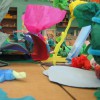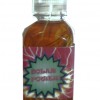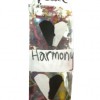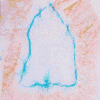-
Recent Lessons
- Keith Haring Murals in San Sebastián
- Keith Haring Murals
- Come To Know Keith Haring
- Organ Systems Mural
- City as Canvas: Artist Spotlight
- Printing with Objects
- Mural Making in the Style Of Keith Haring
- Subway Graffiti Project
- T-shirt Designer
- Keith Haring Semiotics Poster
- Introducing Keith Haring
- Discovering Keith Haring
- Haring Inspired Mural
- All Bottled Up!
- Thinking about Drawings as Symbols
More Resources
Recent Comments
- Daniel Wiener on Symbols & Signs
- Victoria E Sylvestre on Symbols & Signs
- Emoji: Modern Symbol Communication | OH THE ART PLACES WE CAN GO on Thinking about Drawings as Symbols
- coco on Keith Haring Biography
- Crack is Wack II | Muros hablados on Studying Mural: “Crack is Wack”
Subject: Multi-Media
Paper Sculpture Habitats

THIS LESSON USES THE NYC BLUEPRINT LEARNING STANDARDS.
Elementary students design their own mix and matched animals, using a lesson framework that emphasizes transformation, then they create an entire ecosystem for them using 3-dimensional collage materials.
This lesson accompanies the following additional lessons:
"Clay for Fun"
"Cranimals in 3D"
"Creating a Cranimal"
Research and Remedies

THIS LESSON USES THE NYC BLUEPRINT LEARNING STANDARDS.
What if a cure existed for: AIDS? Hunger? Poverty? Racism? Pollution? Corruption?
What would it look like? How can knowledge or understanding function as a cure?
Mixing Up Magic

THIS LESSON USES THE NYC BLUEPRINT LEARNING STANDARDS.
This lesson is designed to allow students to experiment with the roles of scientists and graphic designers. Students will design a magic potion. The lesson gives students a chance to practice math and science skills such as mixing and measuring while learning about color, and design.
Crayon Rubbing Flip Book

THIS LESSON USES THE NYC BLUEPRINT LEARNING STANDARDS.
This flip book lesson is designed to make learning about animation a more tactile, fun experience for young learners by eliminating tracing and bringing the line to life. Students will use their hands to gradually bend and reshape a line (floral wire), while recording this experience using crayon rubbings. The sequential crayon rubbings will become frames for their flip book.
This lesson is originally designed to accompany a math lesson about closed shapes, giving students an experience with the formation of flat sides, curves, and angles.